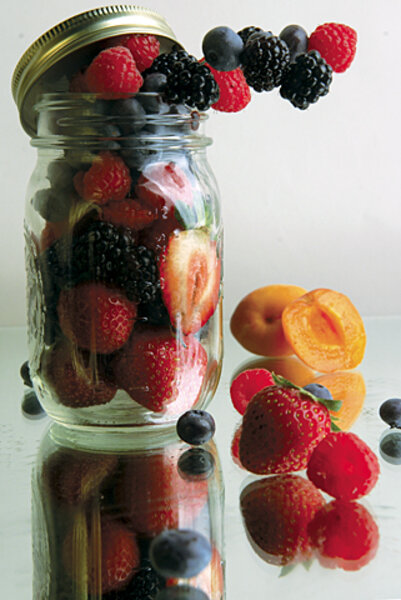The best jams take their sweet time
Loading...
While I was still half a block away walking to my aunt's house, the aroma of sweet preserves reached my nostrils and my mouth watered in anticipation. Sure enough, her sweltering kitchen was filled with steam from two large pots simmering on her wood-fired stove.
She dipped a spoon into a pot and smeared hot, magenta-colored jam on the heel of a fresh loaf of bread for me. Pleasantly tart rose hip jam on warm bread! The experience was heavenly, something you cannot perceive unless you make your own.
Good jams and marmalades are not easy to find. Supermarket shelves are filled with a large selection but many are rather ordinary in taste and much oversweetened.
Making your own is not hard, not even time-consuming – I preserve six 12-ounce jars of fresh-picked wild blackberry jam in less than 90 minutes, from washing the berries to labeling the jars.
Many home cooks make no-cook freezer jams. They are quick, easy – and not particularly good. They never develop the flavor that only the cooking process brings out.
There are two ways to preserve jams: Use commercially available packages of pectin to thicken the fruit, or cook down the liquid until it reaches jam consistency.
If you use pectin, you must maintain the correct chemistry (particularly the amount of sugar you add) or the concoction fails. The process is very quick – as soon as the mixture boils, you stir in the pectin and fill the sterilized jars with the thickened jam.
Evaporating the excess liquid by slow simmering, the way my aunt did, is much slower. For a juicy fruit, it may take an hour with a big bowlful of fruit. But the difference in flavor between the pectin and boil-down methods is amazing. The jam with the instant pectin tastes unfinished and flat, while the reduced jam acquires a rich, slightly caramelized, concentrated fruity flavor. Why?
As the simmering fruit passes the boiling point, the sugars in the fruit start to caramelize and develop a deep fruity taste. As more water evaporates, the flavor concentrates. With pectin, the liquid remains with the fruit, diluting the flavor. When I first realized this flavor difference, I discarded all my packages of pectin.
Caramelize for extra flavor
For an extra-deep flavor I take my jams a step further. I let the mixture cook very slowly for about 10 minutes past the endpoint until the color begins to deepen even more, signaling more caramelization.
The jam now has been enriched with extra flavor, but at this stage the final jam would be too thick, so I dilute the syrup with a small amount of water and continue cooking until it's the right consistency.
The tricky part is catching the exact moment to stop the cooking.
I use two methods to get the jam just right. An accurate thermometer is most reliable: Once you reach 220 degrees F. (lower at higher elevations), your mixture should be perfect.
To double-check, I drop a bit of jam on a cold plate and let it cool for a minute or two. Is it too thin or too thick? I adjust it by cooking it longer or stirring in a small amount of water. It is always safer to shoot for a little too thin (it thickens in the refrigerator) rather than too thick.
As soon as the mixture is perfect, pour it into clean jars, seal, and label. Give some away to someone you truly love.
WILD BLACKBERRY JAM
6 cups (1 lb., 11 oz.) ripe blackberries
4 cups sugar
1/4 cup fresh lemon juice
1 tablespoon grated orange zest
Combine the berries and sugar in a one-gallon heavy, nonreactive pot and bring to a boil. Cook over high heat while watching that the mush doesn't boil over, stirring occasionally until it begins to thicken. Turn heat to low and continue cooking until the mixture reaches jam consistency. The process could take an hour or more.
Continue cooking slowly with frequent stirring for six to 10 minutes more until the mixture is thick and begins to stick to the bottom, a sign of slight caramelization. At this point, stir in a small amount of water and continue cooking until it reaches jam consistency (its temperature should be 220 degrees F.).
Add the lemon juice and cook for a few more minutes, stirring constantly, then check again for consistency by dabbing some on a cold plate and letting it cool. When ready, remove from heat, stir in the orange zest, and put immediately into sterile jars, using a sterile funnel and spoon, to within 1/4 inch from the top. Wipe top edges with a moist paper towel and seal the jars with sterile lids.
Makes 4 cups of blackberry jam.





